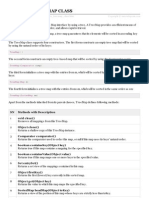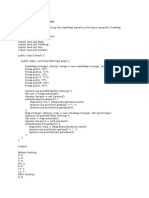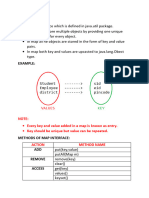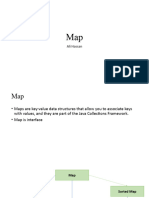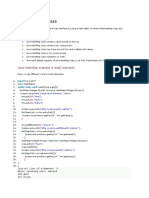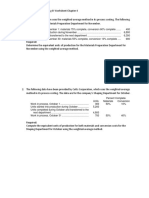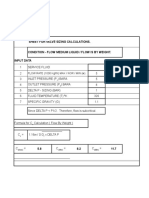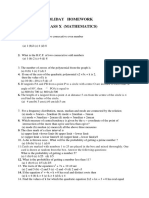0% found this document useful (0 votes)
149 views5 pagesMaps (Interface) : 1. Hashmap (Class) 2. Sortedmap (Interface) 3. Treemap (Class) 4. Linkedhashmap (Class)
The document discusses Maps and TreeMaps in Java. It provides details on the Map interface and its common methods like put(), get(), remove(). It then describes how TreeMaps are implemented using tree data structures with nodes having key, value, color and reference fields. The document gives an example of creating and using a TreeMap with a custom comparator. It also lists various methods specific to TreeMaps like firstKey(), lastKey(), subMap() etc.
Uploaded by
Rahul RaviCopyright
© © All Rights Reserved
We take content rights seriously. If you suspect this is your content, claim it here.
Available Formats
Download as DOCX, PDF, TXT or read online on Scribd
0% found this document useful (0 votes)
149 views5 pagesMaps (Interface) : 1. Hashmap (Class) 2. Sortedmap (Interface) 3. Treemap (Class) 4. Linkedhashmap (Class)
The document discusses Maps and TreeMaps in Java. It provides details on the Map interface and its common methods like put(), get(), remove(). It then describes how TreeMaps are implemented using tree data structures with nodes having key, value, color and reference fields. The document gives an example of creating and using a TreeMap with a custom comparator. It also lists various methods specific to TreeMaps like firstKey(), lastKey(), subMap() etc.
Uploaded by
Rahul RaviCopyright
© © All Rights Reserved
We take content rights seriously. If you suspect this is your content, claim it here.
Available Formats
Download as DOCX, PDF, TXT or read online on Scribd
/ 5
